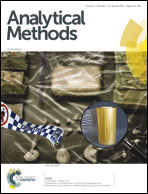A novel chemosensor with visible light excitability for sensing CN− in aqueous medium and living cells via a Cu2+ displacement approach
Abstract
A new and simple julolidine based molecular receptor system L linked to 4-phenylsemicarbazide through an imine moiety has been synthesized and characterized. In HEPES-buffered MeOH–H2O (4 : 1, v/v, pH = 7.4) solution, L selectively binds Cu2+ to form a 1 : 1 ligand/metal complex, leading to a color change from green to yellow and significant fluorescence quenching at 540 nm. The in situ formed L–Cu2+ complex is further utilized to sense cyanide ions with high selectivity and fluorescence enhancement performance via metal displacement assay. The detection limit is 2.28 × 10−7 M and 1.33 × 10−8 M for Cu2+ and CN−, respectively. The sensor has been successfully applied to detect cyanide in water samples. The fluorescence imaging experiments in living cells were also demonstrated, which concludes that the sensor is capable of sensing Cu2+ and CN− in living cells.


 Please wait while we load your content...
Please wait while we load your content...